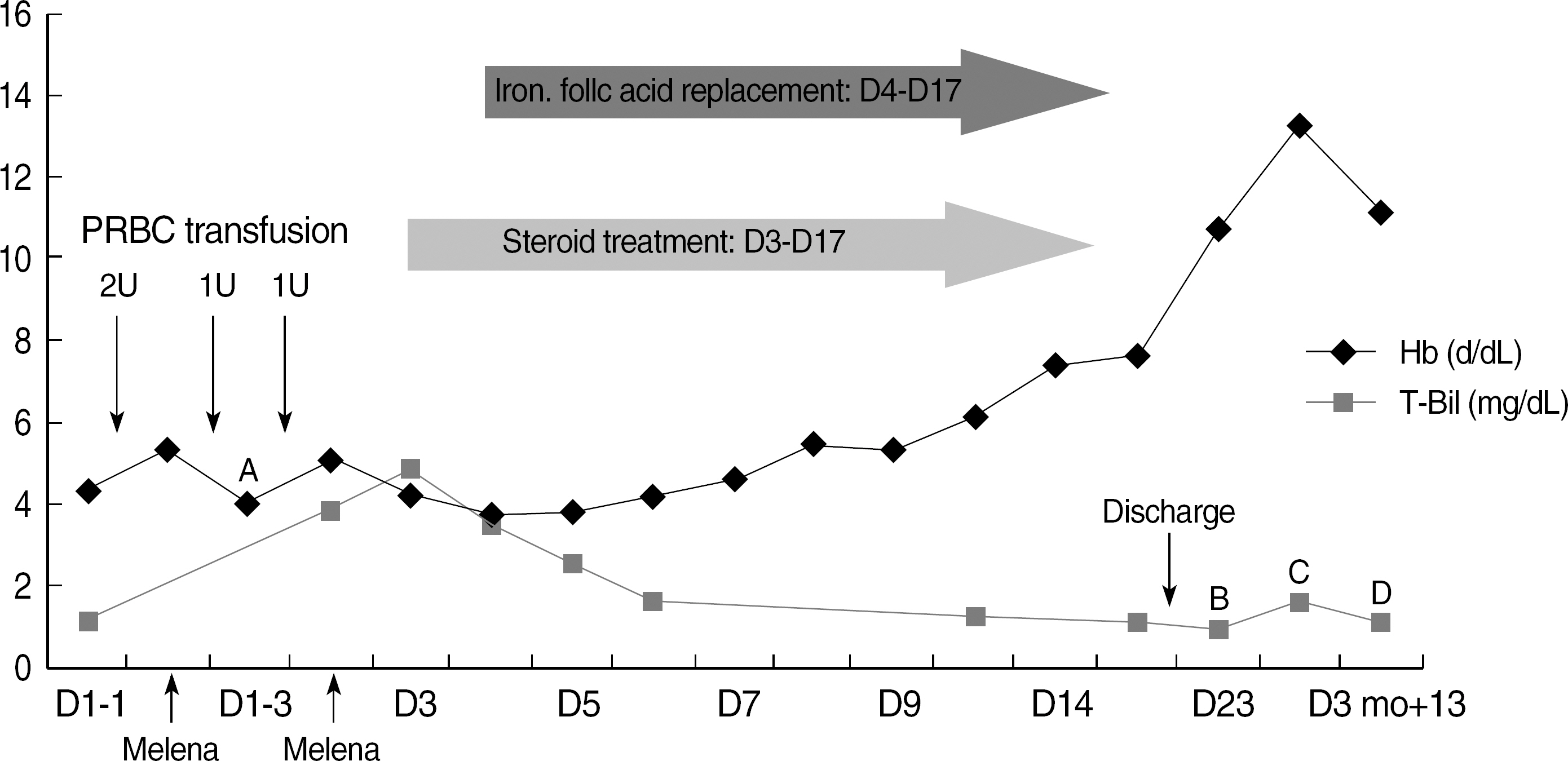Korean J Lab Med.
2009 Jun;29(3):238-242. 10.3343/kjlm.2009.29.3.238.
A Hemolytic Transfusion Reaction due to Anti-Ku Antibody in a Patient with Knull Phenotype: The First Case in Korea
- Affiliations
-
- 1Department of Laboratory Medicine, Ajou University School of Medicine, Suwon, Korea. limyoung@ajou.ac.kr
- 2Department of Gastroentrology, Ajou University School of Medicine, Suwon, Korea.
- KMID: 1096976
- DOI: http://doi.org/10.3343/kjlm.2009.29.3.238
Abstract
- Knull phenotype completely lacks all Kell system antigens. Anti-Ku antibody is seen in immunized persons with Knull phenotype by transfusion or pregnancy. It can cause a fatal hemolytic transfusion reaction. A 66-yr-old male patient with liver cirrhosis visited emergency center due to acute bleeding. The patient was at hypovolemic shock status: his blood pressure was 80/50 mmHg, pulse rate was 110/min and hemoglobin level was 4.4 g/dL. Because of the presence of antibody against high incidence antigen, we could not find any compatible blood for the patient. Nevertheless, 4 units of packed RBCs had to be transfused. Moderate hemolytic transfusion reaction was developed after transfusion. At endoscopic examination, blood was spurting from gastric cardiac varix. Endoscopic histoacryl injection was tried, and bleeding was successfully controlled. After bleeding stopped, he was managed for anemia using steroid and other medical therapy instead of transfusion. His hemoglobin level was improved to 7.7 g/dL at the time of discharge. Later he has been proved to have a Knull phenotype, which is very rare, and anti-Ku antibody. This report is the first case of anti-Ku in a Knull phenotype person in Korea, who experienced a moderate hemolytic transfusion reaction.
MeSH Terms
Figure
Reference
-
1.Beadling WV., Cooling L. Immunohematology. Henry JB, editor. Clinical diagnosis and management by laboratory methods. 21st ed.Philadelphia, PA: WB Saunders;2006. p. 633–6.2.Lin M., Wang CL., Chen FS., Ho LH. Fatal hemolytic transfusion reaction due to anti-Ku in a Knull patient. Immunohematology. 2003. 19:19–21.
Article3.Brecher ME, editor. Technical manual. 15th ed.Bethesda: American Association of Blood Banks;2005. p. 340–3.4.Yu LC., Twu YC., Chang CY., Lin M. Molecular basis of the Kell-null phenotype: a mutation at the splice site of human KEL gene abolishes the expression of Kell blood group antigens. J Biol Chem. 2001. 276:10247–52.5.Manoura A., Korakaki E., Hatzidaki E., Saitakis E., Maraka S., Papamastoraki I, et al. Use of recombinant erythropoietin for the management of severe hemolytic disease of the newborn of a K0 phenotype mother. Pediatr Hematol Oncol. 2007. 24:69–73.
Article6.Lee S., Russo D., Redman CM. The Kell blood group system: Kell and XK membrane proteins. Semin Hematol. 2000. 37:113–21.
Article7.Redman CM., Marsh WL. The Kell blood group system and the McLeod Phenotype. Semin Hematol. 1993. 30:209–18.8.Rolih SD. High-titer, low-avidity (HTLA) antibodies and antigens: a review. Transfus Med Rev. 1989. 3:128–39.
Article9.Yoon SH., Lim YA. A case of anti-Yka antibody as an high titer low, avidity antibody: the first case in Korea. Korean J Blood Transfus. 2008. 19:57–62. (윤석호 및 임영애. 고역가, 저결합성 항-Yka 항체가 검출된 1예-국내 첫 보고. 대한수혈학회지 2008;19:57-62.).10.Chung HJ., Lim JH., Park HJ., Kwon SW. Transfusion of Jra-positive red blood cells to a Jra-negative patient with anti-Jra. Korean J Blood Transfus. 2007. 18:111–5. (정희정, 임지훈, 박현준, 권석운. Anti-Jr 항체양성 환자에게 Jra 항원 양성 적혈구 수혈 경험. 대한수혈학회지 2007;18:111-5.).11.Han KS, Park MH, editors. Transfusion medicine. 3rd ed.Seoul: Korea Medical Publishing;2006. p. 226–7. (한규섭, 박명희 등. 수혈의학. 제3판. 서울: 고려의학, 2006;226-7.).12.Marconi M., Revelli N., Villa MA., Manera MC., Paccapelo C., Magagna V. A regional rare blood donor registry and bank of frozen blood units in ITALY. Transfusion Today. 2008. 76:25.
- Full Text Links
- Actions
-
Cited
- CITED
-
- Close
- Share
- Similar articles
-
- A Case of Delayed Hemolytic Transfusion Reaction Due to Anti-Jka Antibody
- Delayed Hemolytic Transfusion Reaction with Alloimmunization of Rh Phenotype: A Two-Case Study
- A case of acute hemolytic transfusion reaction due to anti-Di(a) antibody: A case report
- Acute Hemolysis Due to Rh Antibodies Against C and e Antigens after Rh-incompatible Transfusion in a Patient, Not Detected During Pre-transfusion Testing
- A Case of Delayed Hemolytic Transfusion Reaction Due to Anti-E(rh")


